Disclosure: Meeple Mountain received a free copy of this product in exchange for an honest, unbiased review. This review is not intended to be an endorsement.
In 1974, inspired by works such as Tolkien’s Lord of the Rings with its intricate plots and fantastical settings, Gary Gygax and Don Kaye created one of the most beloved gaming franchises of all time: Dungeons & Dragons (D&D). Much of the game takes place in the game’s many cities and surrounding villages, but those are largely a backdrop meant to divert the players to the game’s real treasures, the titular dungeons and dragons.
Dungeon delves (or dungeon crawls depending on who you’re speaking to) have become mainstays of gaming all over the world inspiring video game franchises like the Final Fantasy series and Slay the Spire, a wide assortment of role-playing games, and (of course) board games like this one: Tiny Epic Dungeons.
Overview

Cribbed directly from the rulebook, the scene is set. Donning their armor, sharpening their weapons, and memorizing their spells, the players set forth into the dungeon’s depths in the quest to root out and conquer the dungeon’s final boss. But the final boss isn’t the only thing lurking down there. The final boss’s foul minions guard the altars that keep it safe and the dungeon is absolutely crawling with goblins. So. Many. Goblins. Fail to keep the goblin population under control and they will overrun you and your mission will fail.
In a dungeon this deep, your torch is the only thing between you and the crushing darkness. As time goes by, your torch grows ever dimmer. Fail to uncover the boss’s whereabouts in time and the darkness will swallow you and your mission will fail.
As the players enter the dungeon, four passageways open into adjoining rooms. As rooms are explored, more passages will be discovered and new unexplored rooms are added to the map. If you’re ever unable to place an additional room during your explorations, then you’ve reached a figurative and literal dead end and your mission will fail.

In fact, destroying the dungeon’s final boss is the only way to succeed. It’s going to take sound planning, excellent teamwork, and a little bit of luck to succeed. Fortunately for you, others have explored these ruins before you and, having failed themselves, their equipment has been left behind, abandoned to the annals of history. With a discarded spellbook here and a powerful magical weapon there, your characters will grow and become more powerful. And they’re going to need this power because, despite its small size, Tiny Epic Dungeons provides an incredibly difficult challenge.
Before I delve into Tiny Epic Dungeons and how to set it up and play it, I’d like to point out that I am working with the Deluxe Edition of the game which includes the Potions & Perils mini-expansion which is not included with the standard retail version of the game. Also featured in this review is the official Tiny Epic Dungeons game mat which was generously provided to me along with my review copy of the game. If you think the game mat might be something you want, Gamelyn Games has it for sale on their website. The game can absolutely be played without it, though.
And with that out of the way, let’s dig into how to play. Note: there are a lot of intricacies to this game that I am going to gloss over. My goal is to give you a general idea of how everything works without getting too far into the weeds. Hopefully I am successful in this regard. However, if you just want to know what I think about Tiny Epic Dungeons, feel free to skip ahead to the Thoughts section.
General Concepts
Movement
On a player’s turn, they have the option to move and then perform a heroic action or to perform a heroic action and then move. Neither movement nor heroic actions are mandatory, though, but you can’t perform them on the same turn more than a single time apiece.
Each character has a base movement, the maximum number of times the character can move from room to room in a single turn. This is governed by the number listed on the player’s character sheet which they chose during setup.

When moving into an unexplored room, the player will turn the room card face up, rotating it to their liking so that at least one open door matches up with the door they just came through. Then they’ll add face down room cards next to any open passageways. The dungeon layout may never exceed more than three cards in any direction from the entrance.
After rotating the card, the player’s pawn moves into the room. Then the player has to deal with the room’s effect. If the room spawns a monster, the player takes damage and their movement comes to an end. Otherwise, the player has the option to continue moving into the next room after dealing with the current one.
Successfully navigating movement is one of the key elements to doing well at Tiny Epic Dungeons. During setup, the room card deck is divided into three sections. The first third of the deck is pure room cards. The second third is a mixture of room cards and Minions. The final third will contain the Boss’s Lair. The Boss’s Lair cannot be entered until all of the Minions have been defeated and those Minions are tough. If you get too ambitious with your explorative endeavors, you may wind up biting off more than you can chew.
Performing Actions and Skill Checks
Each character has access to a whole litany of heroic actions that they can perform on their turn, most of them highly situational. Find yourself in a room with a trap? Then you can try to disarm the trap. Are you facing down a monster? Then you’ll want to perform the attack action. Low on health (used to keep you alive) and/or focus (used to perform various actions)? Then you might want to rest for a bit. These are just a few examples of things you can do on your turn.
Whether it’s disarming a trap, casting a spell, or searching a room, many of the actions you will be performing over the course of the game are going to require you to perform a skill check. A skill check, for those not in the know, is simply a player-controlled, randomized event (usually a die roll) wherein you’re trying to land within a certain numeric range to determine whether or not your attempt to disarm the trap, cast the spell, etc. is successful. In Tiny Epic Dungeons, there are three different types of skills: strength-based, agility-based, and intellect-based. The character sheet displays these skills with a number of colored cubes next to them—one, two, or three. This determines how many dice you get to roll to perform a specific skill check.

For instance, imagine there is a skill check which demands an agility-based check with a target of 7. You will consult your character sheet to see how many dice you get to roll to perform the check. Each die is numbered from 1 to 6 with the 1s and 2s each being accompanied by a + sign. This is important because out of all of the dice a player rolls, they only get to use a single die to determine their success…unless one or more of the other dice contain + signs. Then those get added to the selected die.
Let’s pretend you can only roll two dice for these kinds of checks. This means that the only way you can succeed is if one of the dice is a 5 and the other is a +2 or if one die is a 6 accompanied by a +1. You might be thinking that you’d have to be awfully lucky to roll the exact combination you needed in order to succeed and you would be correct. There is a whole lot of luck involved. Fortunately, though, you have an extra arrow in your quiver: a ‘free action’ that allows you to spend focus to adjust a single die’s pip value up or down by a single digit, and the dice in this game roll over so 6s can become 1s and vice versa.
The great thing about actions like this one is that they can be performed as many times as you like at any time of your choosing during your turn, provided you have the ability to pay for them. Other examples of useful free actions include things like entering the Boss’s Lair, researching new spells, or revealing adjacent unexplored rooms. This last one is especially useful but also exceptionally dangerous because the way you pay for it involves moving the torch an extra space. As I mentioned earlier, having the torch run out is one of the ways to lose the game.
The Torch Mat
The length of the track on the Torch mat varies based on the player count, but what does not vary is the way that the torch moves and the various effects that will be triggered as the torch moves along its path.
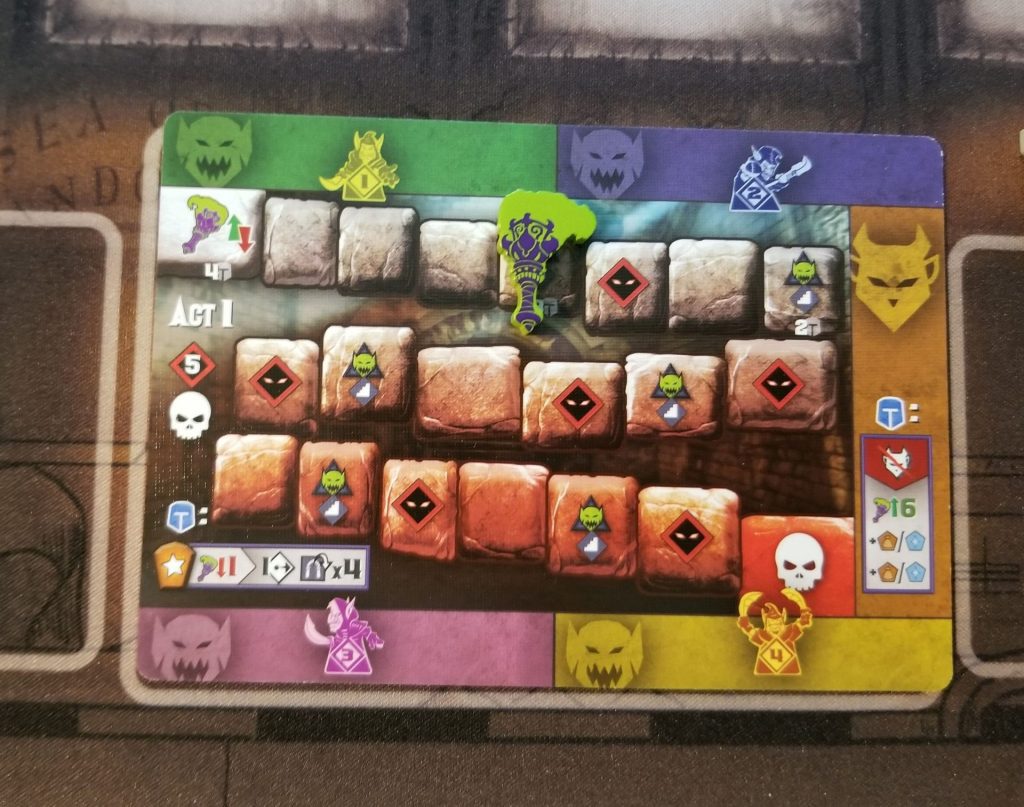
Each time a player finishes their turn, the torch moves ahead a single space. Usually, this doesn’t result in anything happening, but there are two icons that, when the torch lands on them, bad things happen. The first icon will add a goblin to the entrance. The second, and far more dangerous one, causes all of the enemies that are present in the dungeon to perform their actions beginning with the goblins, followed by the minions or the Final Boss.
The actions these monsters perform vary from monster to monster, but they will usually move and/or do some kind of damage to targets that are close by. The damage these monsters do is unavoidable. In fact, the only way to avoid taking damage from monsters is to ensure that you’re nowhere close to them once their movement has ended. That is much easier said than done.
Loot, Spells, and Potions
Each character begins the game with a few basic skills at their disposal, but these skills can be upgraded or amplified through the process of collecting loot, spells, and (if you’re playing with the Potions & Perils expansion) potions. Sometimes you will discover loot or new spells while searching a room, but your primary source of loot and spells will be from slaying monsters. When a monster is defeated, the player can either draw a card from the top of the appropriate deck or they can take a spell or a piece of loot that has been discarded previously.
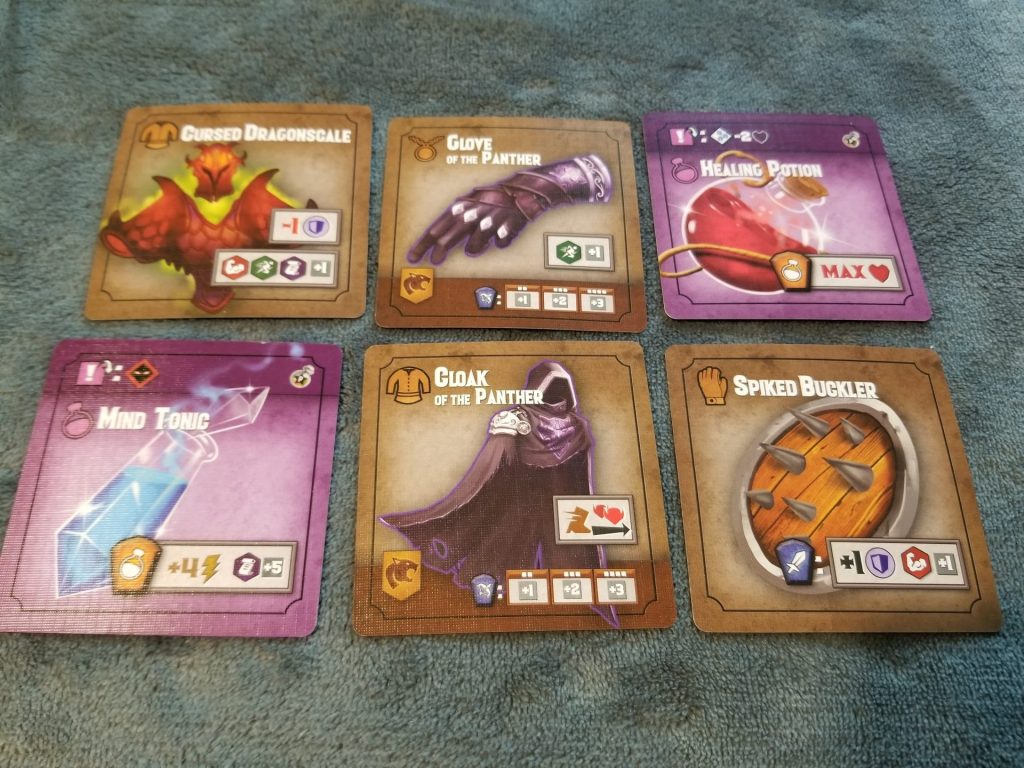
There is no obligation to ever pick anything up and if you should draw something from the deck that isn’t necessarily useful for you, you can leave it behind for someone else. In fact, this is sometimes preferable because not every item is useful for everyone. For instance, there are certain items that provide extra benefits the more pieces of that set you have equipped at any given time, but the benefits provided might not be something your character actually needs.
The End Game
I’ve talked about the various ways the players can lose the game, but I haven’t spent much time talking about how the players can win. Earlier, when I talked about the Torch mat, I neglected to mention that the mat is double-sided. Once the players defeat the minions and one of them enters the Boss’s Lair, the mat gets flipped over and the timer resets. If the players fail to defeat the final boss before the timer runs out, the players lose. Otherwise, they win.
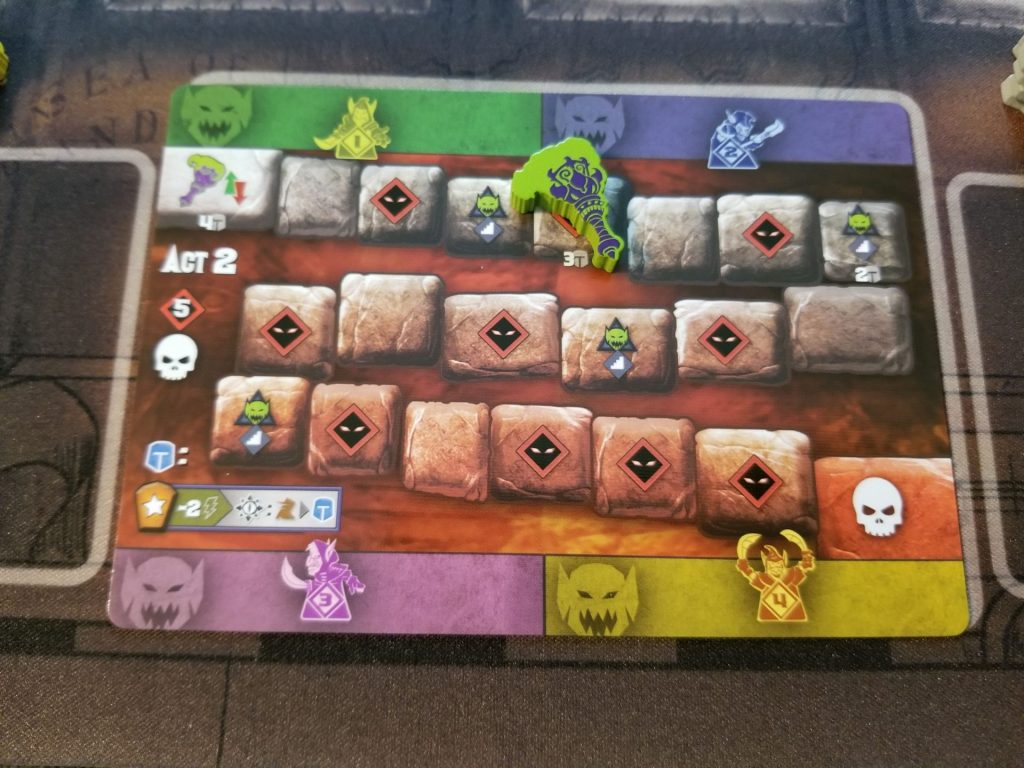
Once a minion is defeated, its health tracker (a little black heart) is placed onto one of the key slots of the face-down Boss card (which will have been randomly selected during setup). Eventually, all of the key slots will be filled in and it is only at this time that a player may enter the Boss’s lair. The Torch mat is flipped and so is the Boss card. That’s when the players discover which final boss they will be fighting.
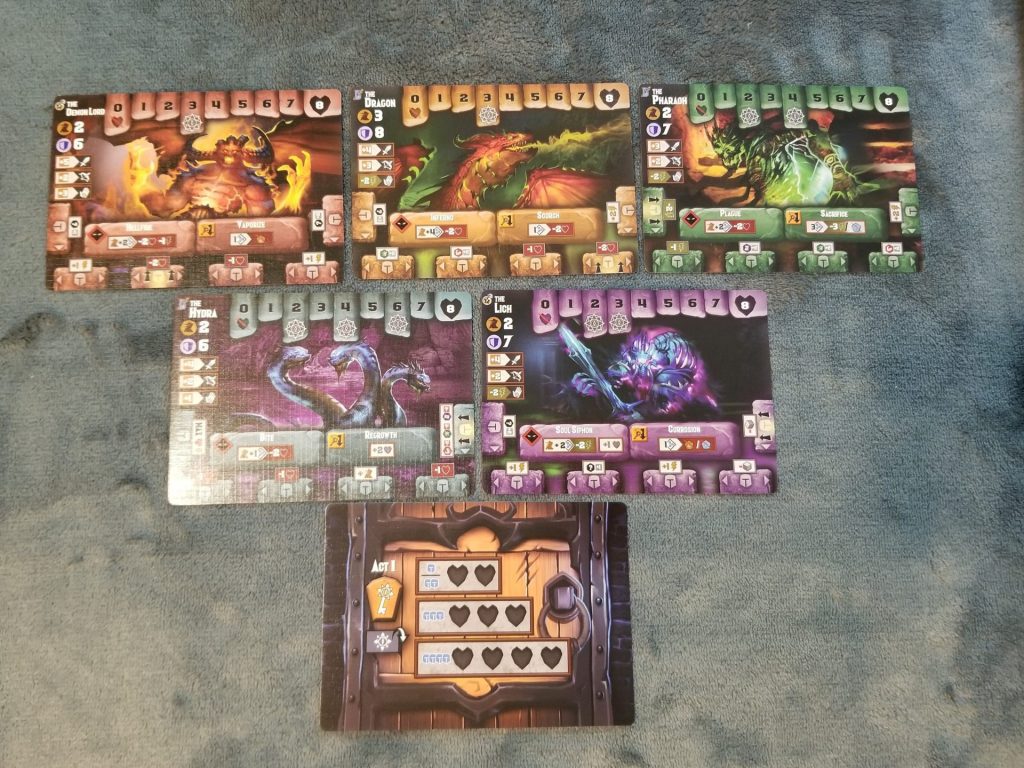
The Boss card has a path running along the edge of the card and players are able to move their characters onto the card to stand on the various spots along the path. Each spot provides some kind of benefit to whoever is standing on top of it. Along the top of the card is the boss’s health bar. All the black hearts from defeating the minions are stacked onto the far right side of the track. As the boss takes damage, the hearts are moved to the left. This means that the players will have to drain the boss to zero health multiple times in order to defeat it.
That sounds easy enough, but there’s a catch. Littered along the boss’s health bar are certain breakpoints that can only be surpassed by luring the boss out of its lair and onto the various altars sprinkled throughout the dungeon (these are the cards that spawn the minions). Each altar visited allows the players to successfully bypass one breakpoint.
Thoughts
What makes a good cooperative game?
It’s a question that I ask myself every time that I play one.
A good cooperative game should have all the hallmarks of a good non-cooperative game. It should be engaging and fun, easy to understand and play, and every minute spent with the game should feel like a minute well spent. Good games never overstay their welcome. A good cooperative game should be all of these, but it should also foster communication and teamwork. Whether the players are banding together against the game itself or against another player (think games like Fury of Dracula), there should always be equal parts confidence and doubt: there’s a good chance the players are going to win, but there’s just as likely a chance that everything is going to come crashing down at any given moment. That doubt lends the game the tension that normally comes from a player’s opponents in other games.
Some cooperative games struggle to find this balance, either being entirely too hard or too easy to the point of not being fun. Unless you’re a sadist that enjoys games like Elden Ring or Dark Souls (both are video games renowned for their extreme difficulty), getting your teeth kicked in by a game over and over again isn’t going to be an experience you’ll want to pursue very often. The flip-side of that coin is playing a game where you’re the one doing the teeth-kicking, also an equally unenjoyable outcome.
I’m not going to pull any punches: Tiny Epic Dungeons lies somewhere in the middle, leaning more towards the getting-your-teeth-kicked-in side of the scale. It’s so ludicrously hard that it comes awfully close to not being fun, but it just barely manages to thread the needle. For the most part, playing Tiny Epic Dungeons is an enjoyable and rewarding experience. It’s got all of those hallmarks of a great game that I discussed earlier. There’s plenty of table talk and teamwork. Everything flows smoothly once you learn to decipher the iconography (and, boy, is there a lot of it). The game’s pacing is spot-on with turns moving quickly enough that you never feel like you’re just sitting around waiting for it to get back around to you.
Then one of your characters dies and everything begins to fall apart.
Once upon a time, there was a video game called Soul Calibur and I lived with a couple of guys that played that game to death. One of my friends was particularly skilled with a character called Mitsurugi and a classic move that he would pull on his opponents was to sweep their feet out from under them and then keep hitting them up into the air over and over until their health ran out. It was a powerful, uncounterable move. Once you were in the air, you were a goner. He employed it so often and so well that nobody wanted to play with him anymore.
Dying in Tiny Epic Dungeons is a lot like that. Once the game’s got you on the ropes, it never lets up.
When you die in Tiny Epic Dungeons, you lie your character’s pawn on its side to signify that it’s out of play. Then your entire next turn must be used to perform a rest action followed by an optional move action. That in itself isn’t so bad. The problem, however, is that the very next thing that happens is that the torch moves and this usually triggers bad things like the monsters performing their actions. Since their movement is roughly equal to or better than yours, your character that just rested cannot get far enough away from them for that rest action to actually achieve anything. All you’ve done is choose the next spot that your character will die. A rest action does not refill your health entirely and it definitely does not refill it enough to absorb the unblockable attacks of multiple enemies.
In Tiny Epic Dungeons, if one of your party members dies, you might as well call the game. It’s nigh unrecoverable. This happens so frequently that it’s not an outlier. In fact, out of multiple plays at various player counts, I have only ever seen the Boss card flipped over once, and that was in a solitaire game. Getting to the final boss takes a great deal of coordination and even more luck, and you might expect that reaching the final boss would result in some kind of action packed spectacular showdown. But, once you’ve reached the final boss… crickets. The game goes from absurdly difficult to unbelievably easy. If you were ever a fan of the TV show LOST and made it all the way through the finale, then you’ll understand the level of confused disappointment that this makes you feel. And here’s why it’s a cakewalk: when the Torch mat flips, the timer resets, and that makes all the difference.
On Torch mat side 1, it’s a race against the clock to not only locate the final boss’s minions, but to defeat them as well. And the whole time you’re doing that, you’re also having to contend with the goblin threat. The looming sense of doom that comes from the Torch mat timer running out lends a desperately needed tension to the game. But when that timer resets, the tension disappears. Suddenly, you’ve got all the time in the world to deal with the new threat that is the final boss. Normally, the boss’s movement would only occur whenever it would perform an action, but there’s a new free action at the players’ disposal: taunt. For a mere two focus, a player may force the boss to move towards them for its maximum movement, and this action can be used over and over so long as the player has the focus to spend on it.
This makes getting the boss to walk over the various altars—which would be quite a challenge if you had to wait for it to perform an action to actually move—no challenge at all. And the whole time it’s moving around, the players can plink away at its health. Even throwing in the occasional goblin spawn isn’t enough to make the boss fight feel challenging. And the whole ‘dragging the boss around the dungeon’ aspect of the fight makes me wonder why there’s even a Boss’s Lair card to begin with. During my boss encounter, the only character that ever spent any time in the Boss’s Lair was the one that triggered the final boss encounter and he wasn’t even in the room for an entire turn. I immediately began luring the boss out because I knew that I’d eventually have to anyway.
However, all of that being said, aside from the final boss fight leaving me feeling underwhelmed, I still thoroughly enjoyed my time with this game. Gamelyn Games attempts to cram a big box board game gaming experience into their very small Tiny Epic packages. Some attempts are more successful than others. Not every game in their Tiny Epic series is a homerun. Tiny Epic Dungeons certainly isn’t, but it’s at least a run to third base and that’s still pretty good.


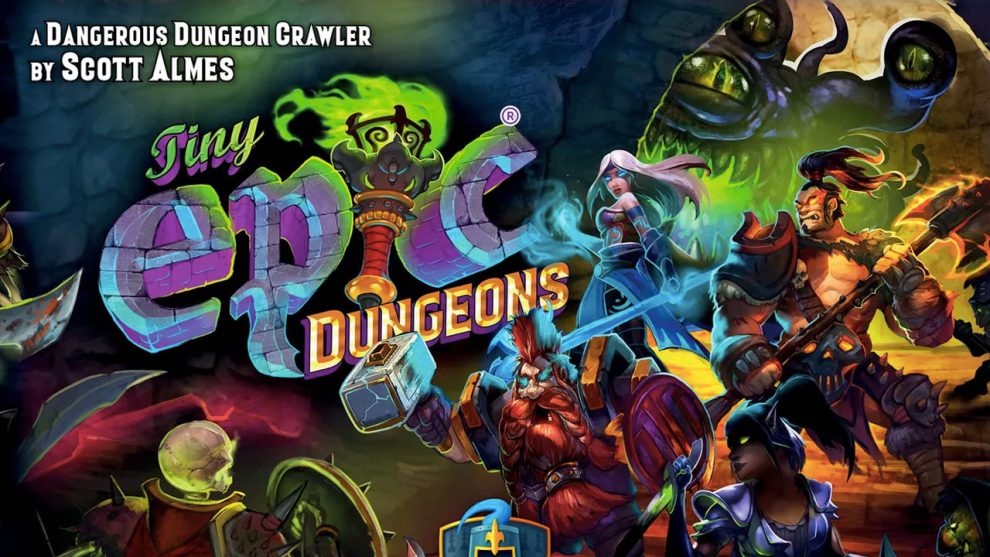
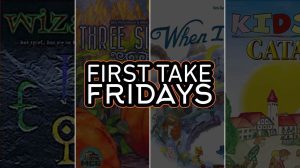

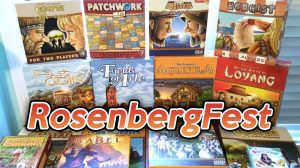





Whilst it is nice to see the late Don Kaye, one of the founders of TSR, who died way too young, for his part in the history of D&D, neither him nor Mr Gygax would have got anywhere without the rules they got and experience of Blackmoor from Dave Arneson. I think he should have got a mention too